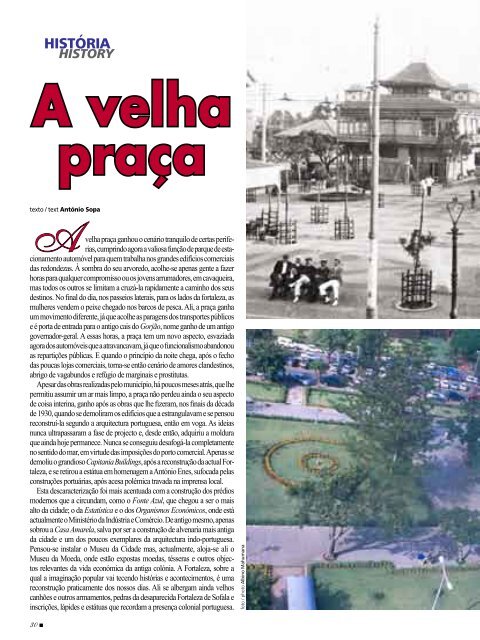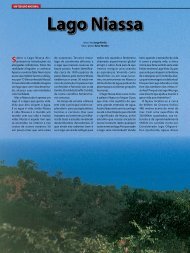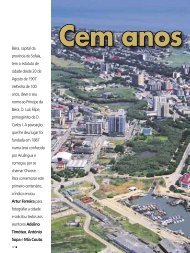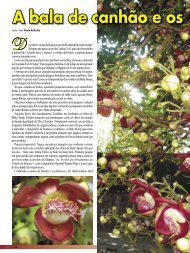Create successful ePaper yourself
Turn your PDF publications into a flip-book with our unique Google optimized e-Paper software.
30<br />
<strong>HISTÓRIA</strong><br />
HISTORY<br />
A velha<br />
praça<br />
texto / text António Sopa<br />
A velha praça ganhou o cenário tranquilo de certas periferias,<br />
cumprindo agora a valiosa função de parque de estacionamento<br />
automóvel para quem trabalha nos grandes edifícios comerciais<br />
das redondezas. À sombra do seu arvoredo, acolhe-se apenas gente a fazer<br />
horas para qualquer compromisso ou os jovens arrumadores, em cavaqueira,<br />
mas todos os outros se limitam a cruzá-la rapidamente a caminho dos seus<br />
destinos. No final do dia, nos passeios laterais, para os lados da fortaleza, as<br />
mulheres vendem o peixe chegado nos barcos de pesca. Ali, a praça ganha<br />
um movimento diferente, já que acolhe as paragens dos transportes públicos<br />
e é porta de entrada para o antigo cais do Gorjão, nome ganho de um antigo<br />
governador-geral. A essas horas, a praça tem um novo aspecto, esvaziada<br />
agora dos automóveis que a atravancavam, já que o funcionalismo abandonou<br />
as repartições públicas. E quando o princípio da noite chega, após o fecho<br />
das poucas lojas comerciais, torna-se então cenário de amores clandestinos,<br />
abrigo de vagabundos e refúgio de marginais e prostitutas.<br />
Apesar das obras realizadas pelo município, há poucos meses atrás, que lhe<br />
permitiu assumir um ar mais limpo, a praça não perdeu ainda o seu aspecto<br />
de coisa interina, ganho após as obras que lhe fizeram, nos finais da década<br />
de 1930, quando se demoliram os edifícios que a estrangulavam e se pensou<br />
reconstruí-la segundo a arquitectura portuguesa, então em voga. As ideias<br />
nunca ultrapassaram a fase de projecto e, desde então, adquiriu a moldura<br />
que ainda hoje permanece. Nunca se conseguiu desafogá-la completamente<br />
no sentido do mar, em virtude das imposições do porto comercial. Apenas se<br />
demoliu o grandioso Capitania Buildings, após a reconstrução da actual Fortaleza,<br />
e se retirou a estátua em homenagem a António Enes, sufocada pelas<br />
construções portuárias, após acesa polémica travada na imprensa local.<br />
Esta descaracterização foi mais acentuada com a construção dos prédios<br />
modernos que a circundam, como o Fonte Azul, que chegou a ser o mais<br />
alto da cidade; o da Estatística e o dos Organismos Económicos, onde está<br />
actualmente o Ministério da Indústria e Comércio. De antigo mesmo, apenas<br />
sobrou a Casa Amarela, salva por ser a construção de alvenaria mais antiga<br />
da cidade e um dos poucos exemplares da arquitectura indo-portuguesa.<br />
Pensou-se instalar o Museu da Cidade mas, actualmente, aloja-se ali o<br />
Museu da Moeda, onde estão expostas moedas, tésseras e outros objectos<br />
relevantes da vida económica da antiga colónia. A Fortaleza, sobre a Mahumana<br />
qual a imaginação popular vai tecendo histórias e acontecimentos, é uma<br />
Albino<br />
reconstrução praticamente dos nossos dias. Ali se albergam ainda velhos<br />
canhões e outros armamentos, pedras da desaparecida Fortaleza de Sofala e photo /<br />
inscrições, lápides e estátuas que recordam a presença colonial portuguesa. foto
The Old Plaza<br />
T he old plaza has been allocated the tranquil aspect of certain outdoor<br />
settings, and now fulfils the valuable function of a car park for those<br />
working in the large commercial buildings around. Its trees provide shade only<br />
for those killing time before an appointment or for the young parkers, as they<br />
stand chatting, but everyone else limits themselves to crossing it quickly en route<br />
to their destinations. At the end of the day, on the walks along the fortress side,<br />
women sell fish brought by the fishing boats. There, the plaza has a different<br />
movement, thanks to the public transport stops and the fact that here is lies<br />
the entrance to the old Gorjão quay, a name inherited from a former Governor-<br />
General. At this time of the day, the plaza has a new aspect, emptied of the cars<br />
that blocked it, since the civil servants have all left their offices. And when night<br />
falls, after the few shops close, it becomes the setting for clandestine love, a<br />
shelter for tramps and for the hideout of marginals and prostitutes.<br />
In spite of municipal work carried out a few months ago to smarten it up,<br />
the plaza has still not lost the makeshift aspect it took on after the work carried<br />
out at the end of the 1930’s, when the buildings that were choking it were<br />
demolished and the intention was to re-build it according to the then vogue<br />
of Portuguese architecture. These ideas never got past the planning stage,<br />
and since then it has acquired its current framework. They never managed to<br />
completely un-choke it on the seaward side, because of the constraints of the<br />
commercial port. They merely demolished the grandiose Capitania Buildings,<br />
after the rebuilding of the current Fortress, and removed the statue honouring<br />
António Enes that was suffocated by the port buildings, after a heated debate<br />
in the local press.<br />
This loss of character was strengthened by the construction of the modern<br />
buildings that surround it, such as the Fonte Azul, which came to be the highest<br />
in the city, the Statistics building and the Economy Offices building, that currently<br />
houses the Ministry for Industry and Commerce. Of the truly old buildings, only<br />
the Casa Amarela remained, saved because it was the oldest masonry building<br />
in the city and one of the few examples of Indo-Portuguese architecture. It was<br />
initially planned to have the City Museum installed there, but nowadays it houses<br />
the Currency Museum, exhibiting coins, tesseras and other relevant objects from<br />
the economic life of the former colony. The Fortress, around which popular<br />
Índico 31
32<br />
<strong>HISTÓRIA</strong><br />
HISTORY<br />
Paralelamente, na antiga capela, guardam-se<br />
os restos mortais do Imperador Ngungunhane,<br />
numa urna de madeira finamente lavrada pelo<br />
escultor Paulo Come, que teve igualmente a<br />
intervenção do pintor Malangatana Valente.<br />
Numa outra das antigas casernas, uma pequena<br />
exposição arqueológica, revela o passado das<br />
populações africanas locais.<br />
Poucos saberão, hoje em dia, que a velha<br />
praça está ligada às origens de Xilunguíne.<br />
Que o antigo campo de tiro da primitiva<br />
fortaleza foi, ao longo dos tempos, assumindo<br />
os mais variados retratos. O mais célebre, que<br />
a internacionalizou, foi feito pelo fotógrafo<br />
Inácio Pó, no seu apogeu, nos frenéticos anos 20. Nesse tempo, a praça era<br />
toda pavimentada ao estilo português, rodeada por quiosques de madeira e<br />
vidro, o primeiro dos quais erguido nos anos 80 do século XIX. Ao centro,<br />
um belíssimo coreto de ferro fundido acolhia semanalmente a banda militar.<br />
Era sob o seu arvoredo, nas esplanadas dos restaurantes e cafés, que a cidade<br />
toda se acolhia, estabelecendo-se novos conhecimentos e reafirmando-se<br />
velhas amizades. Ali se reuniam os comerciantes, na expectativa de concretizarem<br />
lucrativos negócios, oficiais da Marinha e do Exército, em comissão<br />
de serviço, políticos e o grande funcionalismo público ávido de conhecer os<br />
últimos boatos, as famílias respeitáveis, a que se resumia toda a nobreza local,<br />
imagination weaves stories and events, is a practically modern reconstruction.<br />
Old houses and other weapons are housed there, together with stones from<br />
the long-gone Sofala Fortress and inscriptions, memorial stones and statues<br />
recording the Portuguese colonial presence. Also, in the old chapel, the mortal<br />
remains of Emperor Ngungunhane are kept in a finely worked wooden urn,<br />
made by the sculptor Paulo Come, with additional work by painter Malangatana<br />
Valente. In another of the old mansions there is a small archaeological exhibition<br />
showing the past of the local African populations.<br />
Few will know today that the old plaza is linked with the origins of Xilunguíne.<br />
That the old firing range of the primitive fortress gradually took on the most
e todo um mundo de anónimos aventureiros a caminho da vizinha União. A<br />
chegada do “vapor” era também dia grande na povoação. Todos desciam à<br />
Baixa para saber notícias da antiga Metrópole, através da correspondência<br />
e dos jornais. Depois, pacatamente, lá pelas onze horas, regressavam todos<br />
a casa, usando os velhos eléctricos que saíam então da praça.<br />
Depois, tudo mudou. A cidade tinha inevitavelmente crescido e outros<br />
gostos modelavam então a existência dos citadinos. A demolição dos velhos<br />
quiosques, que sobreviviam já numa lenta agonia, vieram acelerar o seu<br />
abandono. E a praça ganhou desde então aquele ar modesto e provinciano,<br />
saudosa das grandezas de outros tempos.<br />
varied aspects over the years. The most famous<br />
image, which put it on the international scene,<br />
was the photograph taken by Inácio Pó, during<br />
its heyday, in the roaring twenties. At that<br />
time, the plaza was completely paved in the<br />
Portuguese style and surrounded by glass and<br />
wood kiosks, the first of which was erected in<br />
the 1880’s. In the centre, a beautiful wrought<br />
iron bandstand housed weekly performances<br />
by the military band. The city meeting place<br />
was beneath its trees, on the esplanades of<br />
the restaurants and cafes. There, people made<br />
new contacts and re-affirmed old friendships. It<br />
was also there that the merchants met hoping<br />
to make profitable new deals. Navy and Army<br />
officers, politicians and senior civil servants keen<br />
to hear the latest rumours, respectable families,<br />
including all of the local nobility, and a whole<br />
world of anonymous adventurers on their way from the neighbouring Union also<br />
met there. The arrival of the “steamboat” was also an important day. Everyone<br />
would go downtown to glean news of the old Metropolis from letters and the<br />
newspapers. Then, at around 11 o’clock, they would all peacefully return home<br />
on the old trolley cars that used to leave from the plaza.<br />
Then, everything changed. The city had inevitably grown and new tastes<br />
had come to define its citizens’ lives. The demolition of the old kiosks that<br />
were still clinging to life in slow agony only accelerated its abandonment. And<br />
since then, the plaza has assumed a modest and provincial air, dreaming of<br />
its former glory.<br />
Índico 33









